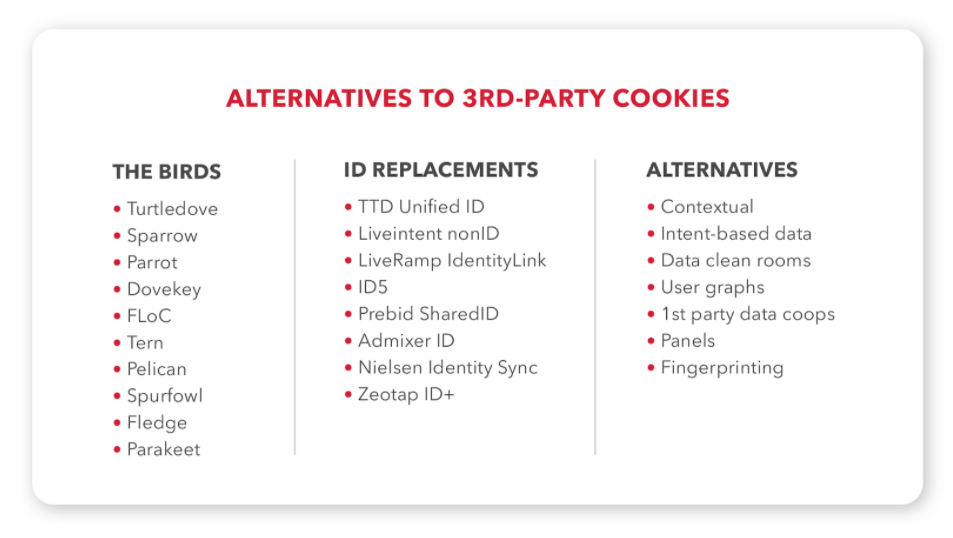
Longread Chrome and Chromium-based browsers will stop supporting third-party cookies in 2022, which will affect everyone in the advertising industry. Traditional digital advertising and monetisation methods will become less effective or even stop working altogether.
In this article, I’ll explain why third-party cookies are getting canceled, how this will affect publishers and advertisers, and what you need to do now so that these changes won’t affect your ad revenue.
Why are third-party cookies going away?
Third-party cookies are online user identifiers that are set by a third-party platform or technology provider on the website the user is visiting. Cookies are stored on the user’s device. Brands have long used third-party cookies to track website visitors, improve user experience, and collect data to target ads to the right audience. The main advantage of third-party cookies for advertisers was that they enabled the tracking of what users were browsing throughout the entire web within a specific browser, not just on the site on which these cookies had been installed.
The third-party cookies cancellation is due to the users’ growing distrust of third-party cookies. The latter doesn’t allow the users to control where and how their personally identifiable information or PII is used.
“Users are demanding greater privacy—including transparency, choice, and control over how their data is used — and it’s clear the web ecosystem needs to evolve to meet these increasing demands,” Google announced in a blog post on March 3, 2021.
That’s also the goal of the data protection regulations created over the past 5 years (for example, the GDPR in Europe and the CCPA in California). One of their main purposes is to inform users about what data is being used and allow them to choose who to entrust their data to.
Although Chrome is not the first browser to disable third-party cookies, it has the highest market share at 64% of all users. Safari (ranked second) and Firefox (ranked third) stopped tracking users via third-party cookies over a year ago.

It’s worth remembering that not all types of cookies will be disabled in early 2022. First-party cookies, which are created by the publisher or advertiser and are not transferred to third parties, will stay in place. Their purpose is to facilitate interaction with the user: remember passwords, search preferences, purchase history, recommendations, items saved in the cart, etc.
How will the changes affect advertisers?
When all major browsers stop supporting third-party cookies, it will become impossible to set up audience targeting and frequency capping for 99% of users. Meanwhile, cross-site audience targeting will become a thing of the past. One way it can play out is that non-personalised ads will overflow the Internet, and the effectiveness of advertising campaigns (ROAS) will decrease.
Orchid Richardson, vice president of programmatic and data centre at Interactive Advertising Bureau (IAB), says that brands turned out to be the least prepared to disable third-party cookies. She claims that advertisers have taken a wait-and-see approach, hoping that someone will come up with an alternative solution for them.
At the same time, the most forward-thinking direct-to-consumer brands have already started activating first-party user data from CRM, CDP platforms, and offline contacts in their advertising campaigns. This allows them to customise retargeting and to sell more products to loyal users.
Advertisers should start collecting and segmenting user data right now. Given that this may require new ad technologies (such as a data management platform [DMP] or a creative management platform [CMP], companies need to find a reliable technology partner to help them with customisation and integration.
What will happen to web publishers?
A recent IAB report revealed that publishers could lose up to $10 billion in ad revenue when third-party cookies are disabled because their ad personalisation options will shrink. According to Google’s research, most publishers could lose 50-70% of their revenue if they don’t reconfigure their approach to ad and data management by 2022.
Why will revenues decrease?
- Brands will redirect advertising budgets to sites with their own authorisation systems that collect and consistently process user data. This includes large technology platforms such as Facebook, Amazon, YouTube, as well as media houses that receive user data after registration.
- Media buying based on CPC (cost-per-click) and CPA (cost-per-action) models will become more popular since they don’t require control over reach and frequency. Nevertheless, such models are less profitable for publishers.
- Advertisers will have less trust in the programmatic ecosystem due to the potential increase in traffic fraud until verification systems are rebuilt to work without third-party cookies.
- Part of the budgets can spill into mobile advertising on Android devices, where targeting options haven’t been limited yet. Apple has already restricted user tracking in iOS14.
Cookies aren’t all there is. What are the alternatives?
Right after Google announced its intention to stop supporting third-party cookies, global adtech leaders started looking for possible alternatives that could replace them. Today, there are more than fifty such solutions out there.

#1: Solutions without personal IDs
In the first column, we can see solutions that will work without targeting specific user IDs. They include some alternatives from Google.
On March 3, 2021, Google announced that its products will no longer use identifiers based on users’ personal data after third-party cookies are cancelled. Instead, Google will focus on cohort analysis for ad targeting.
The most advanced Google solution in this area to date is FLoC (Federated Learning of Cohorts). The FLoC algorithm tracks the websites that the users visit and combines the latter into cohorts of interests that can be targeted with ads. This solution provides that:
- Users are grouped based on similar browsing history, and data isn’t sent to external servers.
- Targeting is based not on individual IDs but on the cohorts to which they belong.
- Cohort ID prevents tracking a specific user between websites.
- For a cohort to be targetable, it must include at least 1000 users.
The FLoC solution is still in development, so it’s too early to know its true effectiveness. We know that Google has postponed FLoC testing in Europe, as it is not yet clear whether this solution complies with the GDPR. The problem is that if the browser adds a user to the cohort and assigns them an identifier, the GDPR may interpret this as a transfer of personal data. Given that users don’t provide publishers with open consent to use their data to create cohorts, Google’s decision may violate current user data privacy policies.
#2: Universal ID solutions
In the second column, we have alternative ID solutions based on data that publishers obtain with users’ consent after they sign up for web resources. These identifiers work with encrypted email addresses and phone numbers.
Universal IDs let you identify users on various platforms and devices, for example, when they’re switching from a browser to a mobile application and vice versa.
Dozens of these solutions are already available. For example, ID5’s product unites British publishers, NetID — German ones, and Admixer ID — those in the CEE region. The ID solution acts as a link between online publishers’ and advertisers’ first-party data, allowing you to compare the user ID from different channels.
#3: Alternative solutions
One of the most promising solutions in the third column is contextual targeting. It allows showing ads to users who view sections on specific topics or visit specific web pages without binding user data. The effectiveness of this solution largely depends on the quality of the website’s schema.
For instance, Forbes USA grouped the website content into highly specific sections (lifestyle, business, entrepreneurship, investment, technology, etc.), which in turn include even more specific categories (cars, sports, finance, leisure, etc.). As a result, the website can offer unique user segments for targeting even without user identifiers.
Context targeting has its tech giants. Namely, the Washington Post, owned by Amazon, is working on its own Arc platform with a module that collects data on users and runs Zeus Prime ads. The company has already unveiled its contextual targeting technology.
#4: IAB initiatives
In February 2020, IAB Tech Lab launched its Rearc project. Its members developed the following principles that underpin alternative solutions for user identification and advertising targeting:
- Accountability. The liability system will include the best practices which advertisers must comply with to meet data privacy requirements. Independent auditors will monitor compliance.
- Addressability. Standards of usage for contextual data and user IDs, including email addresses.
- Taxonomy and Data Transparency Standards. Unification of audience segment names based on data transparency standards.
- Best Practices for User-Enabled Identity Tokens. Recommendations on how to keep email addresses and phone numbers secure and private while running personalised ads.
Last summer, leading media, brands, and tech vendors also started working on the PRAM (Partnership for Responsible Addressable Media) project. Their goal is to create a new infrastructure for commercial relationships on the Internet, which will allow users to maintain privacy, and let brands and media keep their advertising revenue. The members have already released the first version of the document, which describes the future digital advertising principles in as much detail as possible.
While speaking at the IAB ALM 2021 conference, CEO of IAB David Cohen urged Apple and Google to join other market players to work together on developing a solution that will keep the digital advertising ecosystem open and not give certain companies unhealthy competitive advantages.
Conclusion
Although there’s less than a year left to prepare for the 3rd-party cookie cancellation, there is no need to panic. The main thing to do now is to estimate the consequences for your business and find a solution that will let you maintain digital advertising efficiency after 2021.
The leading adtech companies have already released over fifty alternative solutions that will allow publishers to keep monetisation revenues and help advertisers maintain cross-channel targeting and ad attribution. On top of that, various players in the advertising industry focus extensively on reviving contextual targeting and on Google’s alternative solution that analyses user cohorts.
Photo by Christina Branco on Unsplash

Interested in hearing leading global brands discuss subjects like this in person?
Find out more about Digital Marketing World Forum (#DMWF) Europe, London, North America, and Singapore.







Thank you so much for this amazing article
I hate it! A lot of those advertising cookies are crap, but some you really like, for example I like to train, i like to get new information about whats new, I saved that cookie in my CCleaner so it never goes away.